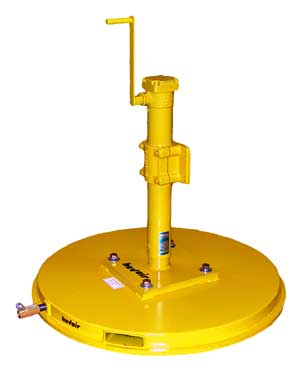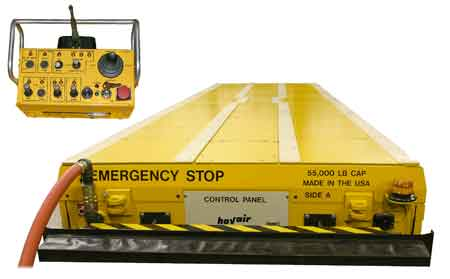In the fast-paced world of industrial logistics, the quest for the perfect balance between efficiency and comfort has never been more critical. Welcome to the realm of ergonomic equipment moving systems, where innovation meets the needs of the modern workplace.
At Hovair Systems, we understand that seamless material handling solutions are the backbone of productivity. In this journey, we’ll unveil the hidden pains of traditional material handling equipment and how ergonomic solutions can ease the burden. Join us as we explore a realm where ergonomic excellence reigns supreme.
Types of Ergonomic Equipment Moving Systems in Material Handling
Ergonomic equipment moving systems play a pivotal role in ensuring efficiency, safety, and comfort within the workplace. These systems are designed to streamline the process of transporting goods and materials, reducing the risk of workplace injuries and fatigue.
In this section, we’ll delve into the two primary categories of ergonomic equipment moving systems: manual and powered solutions.
Manual Equipment Moving Solutions
Manual equipment moving solutions are the backbone of many industries, providing versatility and ease of use for a wide range of applications.
They empower workers to move materials with precision and minimal physical strain. Here are two key categories within this domain:

· Hand Trucks and Dollies
Hand trucks and dollies are fundamental tools in the world of material handling. These devices feature a simple yet ingenious design, with a pair of wheels and a handle for easy maneuverability. Workers can stack and transport boxes, crates, and other items efficiently.
According to the U.S. Bureau of Labor Statistics, hand trucks and dollies are used in various industries, reducing the risk of musculoskeletal injuries caused by manual lifting, especially for packages weighing over 50 pounds.
· Lifting Aids and Devices
Lifting aids and devices encompass a wide range of ergonomic tools. These can include lifting straps, vacuum lifters, and ergonomic lifting platforms.
These devices are designed to assist workers in safely lifting and moving heavy loads. The proper utilization of lifting aids not only enhances efficiency but also minimizes the risk of back injuries and strain, contributing to a healthier and more productive workforce.
Powered Equipment Moving Solutions
Powered equipment moving solutions bring automation and increased lifting capacity into the equation, further enhancing efficiency and reducing the physical demands on workers. Here are three notable categories:
· Electric Pallet Jacks
Electric pallet jacks, often referred to as electric pallet trucks or walkie-pallet jacks, are widely used in warehouses and distribution centers. These powered vehicles enable operators to lift and transport palletized loads effortlessly.
They are particularly beneficial for long-distance transport and vertical stacking, reducing the physical exertion required by manual pallet jacks.

· Forklifts and Stackers
Forklifts are the workhorses of material handling. These powerful machines can lift and move heavy loads with precision. They come in various types, such as counterbalance forklifts, reach trucks, and order pickers. Forklifts are essential in industries dealing with heavy materials, construction, and logistics.
· Conveyor Systems
Conveyor systems are an integral part of material handling solutions in manufacturing and distribution facilities. These systems automate the movement of goods, reducing the need for manual transportation.
A Mordor Intelligence report states that the global conveyor systems market is projected to grow at a CAGR of over 4% from 2023 to 2028, indicating their increasing importance in material handling automation.

Features and Design Considerations
In the world of material handling equipment, ergonomic design principles play a pivotal role in ensuring that the workplace remains efficient and safe.
Ergonomic equipment moving systems are designed with the comfort and well-being of workers in mind, making the task of transporting heavy loads more manageable.
In this section, we will delve into the essential features and design considerations of ergonomic equipment moving systems.
Ergonomic Design Principles
Ergonomic design principles are the foundation of efficient and comfortable equipment moving systems. Discover how adjustable components, user-friendly controls, and weight distribution enhance workplace well-being.Top of Form
· Adjustable Components
One of the key elements of ergonomic equipment moving systems is the presence of adjustable components. These systems are designed to cater to a wide range of users, each with different physical attributes.
Adjustable handles, grips, and supports ensure that operators can customize the equipment to fit their specific needs, promoting a comfortable and efficient work experience.

· User-Friendly Controls
Ergonomic equipment moving systems are equipped with user-friendly controls that are intuitive and easy to operate. This feature not only reduces the learning curve for new users but also minimizes the risk of errors during operation.
A well-designed control interface ensures that workers can focus on the task at hand, enhancing productivity.
· Weight Distribution and Balance
Achieving proper weight distribution and balance is paramount in ergonomic design. By distributing the weight of the load evenly and ensuring a balanced center of gravity, these systems help prevent strain and fatigue on operators. This design consideration is essential for reducing the risk of musculoskeletal injuries in the workplace.
Safety Features
In the realm of ergonomic equipment moving systems, ensuring workplace safety is paramount. Explore the essential safety features that protect operators and prevent accidents during material handling tasks.Top of Form

· Load Securing Mechanisms
Safety is of paramount importance in any material handling solution. Ergonomic equipment moving systems incorporate load-securing mechanisms to prevent the accidental shifting or falling of loads during transport.
Whether it’s straps, clamps, or locking mechanisms, these features provide peace of mind to operators and reduce the risk of workplace accidents.
· Anti-Fatigue Features
Long hours of moving heavy loads can take a toll on the body. To combat fatigue and discomfort, ergonomic equipment moving systems often include anti-fatigue features such as cushioned grips and shock-absorbing components. These elements help reduce the physical strain on operators and contribute to their overall well-being.

Material and Build Quality
The quality of materials used in the construction of ergonomic equipment moving systems is crucial. High-quality, durable materials ensure that the equipment can withstand the rigors of daily use in industrial settings.
Strong, reliable components not only extend the lifespan of the equipment but also enhance safety by reducing the likelihood of breakdowns or failures during operation.
Customization Options
No two material handling scenarios are exactly alike, and ergonomic equipment moving systems recognize this diversity. They often offer customization options that allow businesses to tailor the equipment to their specific needs.
Whether it’s choosing different load capacities, sizes, or additional accessories, customization ensures that the equipment seamlessly integrates into the workflow of the organization.
Benefits of Ergonomic Equipment Moving Systems in Material Handling Solutions
Ergonomic equipment moving systems have become indispensable in today’s workplaces, transforming the landscape of material handling equipment. These systems prioritize the well-being of workers while enhancing operational efficiency.
In this section, we will delve into the key benefits of ergonomic equipment moving systems, shedding light on their pivotal role in improving workplace safety, increasing efficiency, and reducing workplace injuries and fatigue.
1. Improved Workplace Safety
The safety of workers is paramount in any industrial setting, and ergonomic equipment moving systems play a pivotal role in ensuring a secure work environment.
According to the Occupational Safety and Health Administration (OSHA), overexertion and musculoskeletal disorders (MSDs) are among the leading causes of workplace injuries. Ergonomic equipment moving systems are specifically designed to mitigate these risks.

By integrating ergonomic principles into material handling solutions, these systems reduce the need for manual lifting, pushing, or pulling of heavy loads.
For instance, powered equipment like electric pallet jacks and forklifts can effortlessly transport heavy items, reducing the strain on workers.
This not only minimizes the risk of injuries but also fosters a safer work atmosphere by decreasing the likelihood of accidents caused by manual handling errors.
1. Increased Efficiency and Productivity
Efficiency is a cornerstone of any successful business, and ergonomic equipment moving systems are instrumental in achieving higher levels of productivity. These systems streamline material handling operations, allowing for quicker and smoother transportation of goods.
By automating certain tasks and providing ergonomic designs that reduce physical exertion, workers can complete their tasks more swiftly and with fewer disruptions. This efficiency boost translates into increased output, shorter lead times, and, ultimately, enhanced profitability.

For instance, conveyor systems integrated with ergonomic controls enable the seamless movement of materials, ensuring that production lines run smoothly without delays.
This efficiency not only benefits the company’s bottom line but also enhances the overall job satisfaction of employees who can see the positive impact of ergonomic solutions on their daily work.
1. Reduction in Workplace Injuries and Fatigue
Workplace injuries and fatigue not only lead to human suffering but also result in significant costs for businesses. According to a report by the National Institute for Occupational Safety and Health (NIOSH), ergonomic-related injuries cost U.S. businesses billions of dollars annually. Ergonomic equipment moving systems address this issue proactively.
By minimizing manual lifting and repetitive motions, these systems significantly reduce the risk of musculoskeletal disorders and other ergonomic-related injuries.
Moreover, they help combat worker fatigue, as employees are less likely to experience physical strain and exhaustion during their shifts.
As a result, absenteeism due to injuries decreases, and employees report higher job satisfaction, which fosters a healthier and more motivated workforce. This not only improves employee retention rates but also contributes to a positive organizational culture.

Considerations for Implementation
Implementing ergonomic equipment moving systems in your workplace requires careful planning and execution. In this section, we will delve into key considerations to ensure a smooth transition and maximize the benefits of these systems.
1. Assessing the Specific Needs of Your Workplace
Before investing in ergonomic equipment moving systems, it’s crucial to conduct a comprehensive assessment of your workplace’s unique requirements. This involves evaluating your material handling needs, the types of materials or products you handle, the layout of your facility, and the specific challenges your employees face.
According to a recent study by the Occupational Safety and Health Administration (OSHA), ergonomic-related injuries account for approximately 33% of all workplace injuries in the United States. This statistic emphasizes the importance of tailoring your ergonomic solutions to address the specific challenges within your workplace.
Consider consulting with your employees who are directly involved in material handling to gain insights into their daily tasks and pain points. By understanding their needs, you can make informed decisions when selecting the most suitable ergonomic equipment and solutions.
Budget Considerations and Cost-Benefit Analysis
While investing in ergonomic equipment moving systems may require an initial financial commitment, it’s essential to view it as an investment in your workplace’s efficiency and employee well-being.
Conduct a detailed budget analysis to determine the costs associated with purchasing, installing, and maintaining these systems. Take into account not only the equipment’s price but also any additional expenses such as training and ongoing maintenance.
To put this into perspective, a recent survey by the National Institute for Occupational Safety and Health (NIOSH) found that companies that invested in ergonomic solutions experienced a 64% reduction in workers’ compensation costs related to musculoskeletal disorders. This demonstrates the potential for significant long-term cost savings through ergonomic investments.
Perform a cost-benefit analysis that compares the upfront costs with the expected benefits, including reduced workplace injuries, increased productivity, and improved employee satisfaction. This analysis will help you make an informed decision and secure the necessary budget for your ergonomic equipment moving systems.
2. Employee Training and Education
Transitioning to ergonomic equipment moving systems also requires a focus on employee training and education. Even the most advanced systems are only effective when employees know how to use them correctly. Develop comprehensive training programs that teach employees how to operate the equipment safely and efficiently.
Consider implementing ongoing training and refresher courses to keep your workforce up-to-date with best practices. Encourage open communication between management and employees to address any concerns or issues that may arise during the transition.
By investing in your employees’ knowledge and skills, you can create a workplace culture that values safety, efficiency, and well-being. This, in turn, will contribute to the long-term success of your ergonomic material handling solution.

Embrace Ergonomics for a Better Tomorrow – Take Action Now!
As we draw the curtain on this exploration of ergonomic marvels, the path to efficiency and comfort has been illuminated. But don’t let it end here! Dive deeper into the world of ergonomic equipment moving systems by exploring our website.
Discover how our solutions can transform your workplace. Reach out to us today, and let’s embark on a journey towards safer, more productive, and happier work environments. Your success story awaits. Visit us now and experience the ergonomic revolution firsthand.
